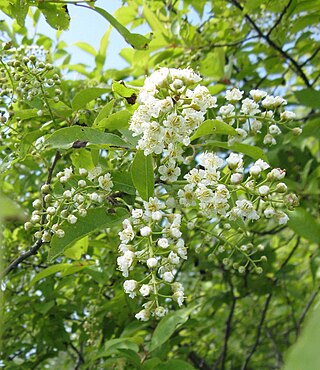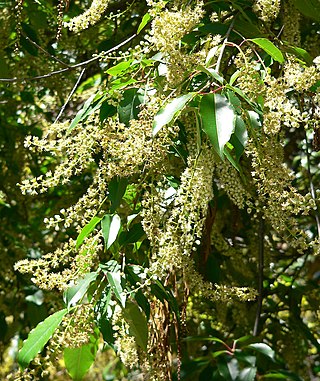
Prunus spinosa, called blackthorn or sloe, is a species of flowering plant in the rose family Rosaceae. The species is native to Europe, western Asia, and regionally in northwest Africa. It is locally naturalized in New Zealand, Tasmania, and the Pacific Northwest and New England regions of the United States.

Prunus virginiana, commonly called bitter-berry, chokecherry, Virginia bird cherry, and western chokecherry, is a species of bird cherry native to North America.

Prunus salicina, commonly called the Japanese plum or Chinese plum, is a small deciduous tree native to China, Taiwan and Southeast Asia. It is an introduced species in Korea, Japan, Israel, the United States, and Australia.

Prunus cerasoides, commonly known as the wild Himalayan cherry,sour cherry or pahhiya is a species of deciduous cherry tree in the family Rosaceae.

Prunus pensylvanica, also known as bird cherry, fire cherry, pin cherry, and red cherry, is a North American cherry species in the genus Prunus.

Prunus americana, commonly called the American plum, wild plum, or Marshall's large yellow sweet plum, is a species of Prunus native to North America from Saskatchewan and Idaho south to New Mexico and east to Québec, Maine and Florida.

Prunus incisa, the Fuji cherry, is a species of flowering plant in the family Rosaceae, which gets its scientific name from the deep incisions on the leaves. It is an endemic species in Japan and grows wild in Kantō, Chūbu and Kinki regions. It is called the Fuji cherry because it grows in particular abundance around Mount Fuji and Hakone. A dainty slow-growing, early white-flowering cherry tree, this century-old cultigen from Hondo, Japan is highly regarded as an ornamental but the wood has no industrial value. It is hardy to -20 °C, and crossed with Prunus speciosa, has yielded the cultivar Prunus 'Umineko'. It is in the ornamental section Pseudocerasus of the cherry subgenus Cerasus of the genus Prunus. Ma et al. classified it in a group with Prunus nipponica.
Prunus polystachya, also called bat laurel, is a species of plant in the family Rosaceae. It is endemic to Singapore.

Prunus fremontii is a North American species of plants in the rose family, known by the common name desert apricot. It takes its scientific name from John C. Frémont. It is found in northern and western Baja California especially, mostly Pacific and western, and the adjacent area of southern California. It also occurs in northern Baja California Sur.

Prunus caroliniana, known as the Carolina laurelcherry, Carolina cherry laurel, Carolina cherry, or Cherry laurel, is a small evergreen flowering tree native to the lowlands of Southeastern United States, from North Carolina south to Florida and westward to central Texas. The species also has escaped into the wild in a few places in California.

Prunus angustifolia, known commonly as Chickasaw plum, Cherokee plum, Florida sand plum, sandhill plum, or sand plum, is a North American species of plum-bearing tree. It was originally cultivated by Native Americans before the arrival of Europeans. The species' name angustifolia refers to its narrow leaves. It became the official state fruit of Kansas in 2022.
Prunus gentryi is a species of wild cherry in the genus Prunus, family Rosaceae, native to the Mexican states of Chihuahua and Sonora. It grows along streambanks in mountainous regions of the Sierra Madre Occidental. The scientific description was published in 1937.

Prunus brigantina, called Briançon apricot, Briançon plum, marmot plum, and Alpine apricot, is a wild tree species native to France and Italy. Its fruit is edible and similar to the commercial apricot P. armeniaca, but it is smooth unlike apricots. An edible oil produced from the seed, 'huile des marmottes', is used in France.
Prunus havardii, called Havard's wild almond or Havard's plum, is a rare North American species of shrub tree native to western Texas in the United States and to northern Chihuahua across the Río Grande in Mexico. It is in the genus Prunus in the rose family, Rosaceae.

Prunus minutiflora, called the Texas almond, is a shrub native to Texas and northern Mexico.

Prunus myrtifolia, called the West Indies cherry or myrtle laurel cherry, is a New World species of shrubs in the family Rosaceae.

Prunus davidiana is a species in the genus Prunus in the family Rosaceae. It is also known by the common names David's peach and Chinese wild peach. It is native to China, preferring to grow in forests and thickets, on slopes in mountain valleys, and in waste fields, from 800 to 3200 m. It is resistant to frost, and to a number of pests and diseases of cultivated peach, and is the subject of many studies for the genetic improvement of peaches.
Prunus brasiliensis is a species of tree in the family Rosaceae. It is native to Brazil and north-eastern Argentina.

Prunus brachybotrya is a species of tree in the family Rosaceae. It is native to Mexico. Individuals have been found growing in Central American countries. The resplendent quetzal has been observed feeding on this tree.
Prunus undulata, which goes by a number of common names including Chinese: 尖叶桂樱, lekh arupate and theiarlung, is a species of laurel cherry native to southeast Asia, including Nepal, Bhutan, Sikkim, Bangladesh, northeastern India, Myanmar, southeastern China, Aceh in Indonesia, Laos, Thailand and Vietnam. A tree reaching 16 m, prefers to grow alongside streams at 500 to 3600 m above sea level. A widespread and successful species, it has been repeatedly described, resulting in a plethora of synonyms. Of these, the specific epithet capricida refers to its legendary ability to poison goats who consume it.















